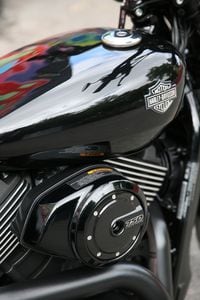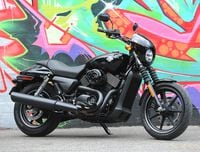There are so many things to talk about when we talk about Harley-Davidson's Street 750, appearing in American dealerships this month. It's a made-for-beginners middleweight, not a traditional heavyweight cruiser. It's liquid cooled, not air-cooled. The bulk of the bike is made in India and elsewhere, not Milwaukee (though it's assembled in America). Is this or is this not a "real" Harley-Davidson?
Much will be said about the Street's liquid-cooled, 750cc Revolution X powerplant (a smaller 500cc version is also offered). Forget that X Games promo video of AMA National Champion Brad Baker backin' it in aboard a Street-based flat-track racer—this isn't a performance bike. Power is middling, though the low-end torque is ample and accessible thanks to flawless throttle mapping, a smooth-shifting transmission, a light clutch, and lash-free belt final drive. Perfect, in other words, for beginner bike. If you haven't ridden many—or any—other motorcycles, the Revolution X will feel perfect to you.
More will be said about the chassis, which is likewise non-threatening. Brakes are adequate, just. The soft-biting single front disc and oddly angled rear brake pedal make it difficult to grab too much brake—perhaps a good thing, since ABS isn't an option. The Street might offer twice the suspension travel of an Iron 883 Sportster, but with what feels like half the damping—not ideal when you're pushing the pace, but oh-so-plush at learner's permit speeds. Then there's the riding position. Harley says the "voice of the customer" was more persuasive for this bike than any other before, but just because entry-level customers always ask for an ever-lower seat doesn't mean they are always right. A narrow bar, ultra-low, 25.7-inch saddle height, and footpegs that are slightly too forward and slightly too wide apart cramped my 5'7" frame, and became excruciating 70 miles into a 140-mile test ride. That the accessory catalog includes a taller seat option tells you everything.
Still more words will go toward explaining—or explaining away—sub-par details that betray the price point build (the Street 500 sells for just $6799; the 750 is $7499). The galvanized swingarm bolts and rear axle hardware look sourced from Harbor Freight, the stamped foot controls from a lawn tractor, and so much exposed wiring with fragile-looking, Playskool-colored plastic connectors are disappointing from a company famous for fine fit-and-finish. From further away, however, the Street is a handsome motorcycle, with clean, category-defying styling—Is it a cruiser? A standard? A sporty naked?—that makes it a perfect canvas for customization, suitable to build a café racer, street tracker, scrambler, or, yawn, even an old-school chopper.
You could say all that and more, but none of it—not the acceleration, the braking, the ergonomics, or even the styling or build quality—really matters. Harley-Davidson will still probably sell more Street models than any of us might ever imagine, for the same reason it sells more Sportsters and Softails and other motorcycles than anyone else in America (260,000-plus bikes sold in 2013)—because Harley-Davidson motorcycles are indisputably cool. No matter what story the objective specifications tell, subjectively, the Street, with that iconic bar-and-shield icon affixed to the rakish fuel tank, is automatically cool too.
This isn't an accident. Harley-Davidson works harder than any other motorcycle manufacturer to give their bikes that elusive cool factor, and they absolutely excel at that task. It's no coincidence the Street 750 intro took place in Austin, Texas, on the same day the X Games—the apex of youth culture—kicked off. Harley-Davidson has been an active participant in the action sports world for years, sponsoring events like X Games—their bar-and-shield was featured prominently above the half-pipe used for the BMX and skateboard events at X Games Austin—and directly supporting countless skateboarders, BMX riders, and other extreme athletes.
Harley-Davidson has done more in the past five years than any other motorcycle OEM—maybe more than all the other OEMs combined—to make motorcycling look cool and attractive to young, hip, non-endemic clientele. It's no surprise, then, that Harley-Davidson is currently the best-selling motorcycle brand to young adults aged 18-35 in the over-500cc displacement category, and has been since 2008. This is why there are so many more skinny-jean hipsters riding archaic, outdated Sportsters and Street Glides than modern, high-tech CBRs or even Ducati Monsters. Now that the Street offers the same elusive X factor plus better ride dynamics, easier customization, and a lower price, there's no reason to think there won't be even more kids on Harleys in the coming years.
As former Motorcyclist staffer/"Bitter Little Man" John Burns sagely pointed out at a gas stop during this press ride, any motorcycle is only as cool as the person riding it. The Street 750 is decidedly unhip surrounded by a bunch of gray-haired motojournalists grouching about wooden brakes and a too-soft saddle. When a pro skateboarder like Greg Lutzka roll up to the front door of the W Hotel in downtown Austin astride the Street, however, it looks like the coolest motorcycle in the world. That alone already makes the Street a success.














/cloudfront-us-east-1.images.arcpublishing.com/octane/MUQLOVLL2ZDGFH25ILABNBXKTI.jpg)
/cloudfront-us-east-1.images.arcpublishing.com/octane/TNOU5DNE2BC57MFPMGN2EIDXAM.jpg)
/cloudfront-us-east-1.images.arcpublishing.com/octane/GTCXACQGJ5HAPDTGWUQKDEH44E.jpg)
/cloudfront-us-east-1.images.arcpublishing.com/octane/S35YGSEMEZB4BLTDJTSZPF4GLA.jpg)
/cloudfront-us-east-1.images.arcpublishing.com/octane/5UOT6HPX2JFMRJAX6EH45AR4MQ.jpg)
/cloudfront-us-east-1.images.arcpublishing.com/octane/OKWOJWAKP5EP3OACCRRWPCIX2Q.jpg)
/cloudfront-us-east-1.images.arcpublishing.com/octane/2WF3SCE3NFBQXLDNJM7KMXA45E.jpg)
/cloudfront-us-east-1.images.arcpublishing.com/octane/G4MG6OUCJNBSHIS2MVVOTPX65E.jpg)
/cloudfront-us-east-1.images.arcpublishing.com/octane/IIGGWFOTOJGB7DB6DGBXCCMTDY.jpg)
/cloudfront-us-east-1.images.arcpublishing.com/octane/QSTCM6AVEZA5JJBUXNIQ3DSOF4.jpg)
/cloudfront-us-east-1.images.arcpublishing.com/octane/U4I7G625B5DMLF2DVIJDFZVV6M.jpg)
/cloudfront-us-east-1.images.arcpublishing.com/octane/B6XD6LS6IVCQPIU6HXDJSM3FHY.jpg)
/cloudfront-us-east-1.images.arcpublishing.com/octane/ICL63FEDDRDTTMINYICCEYGMDA.jpg)
/cloudfront-us-east-1.images.arcpublishing.com/octane/FCGZHQXRBZFLBAPC5SDIQLVF4I.jpg)
/cloudfront-us-east-1.images.arcpublishing.com/octane/WNOB6LDOIFFHJKPSVIWDYUGOPM.jpg)

/cloudfront-us-east-1.images.arcpublishing.com/octane/X33NU3E525ECRHXLNUJN2FTRKI.jpg)
/cloudfront-us-east-1.images.arcpublishing.com/octane/6KKT5NNL2JAVBOXMZYS5ZO76YA.jpg)
/cloudfront-us-east-1.images.arcpublishing.com/octane/J5RKG5O455GMPGQRF2OG6LRT7A.jpg)
/cloudfront-us-east-1.images.arcpublishing.com/octane/GX2CIZKQVRH2TATDM26KFG2DAE.jpg)
/cloudfront-us-east-1.images.arcpublishing.com/octane/ZWIDYSAKQZHD5BHREMQILXJCGM.jpg)
/cloudfront-us-east-1.images.arcpublishing.com/octane/CYUHJZCTSJCH3MRAQEIKXK7SCQ.jpg)
/cloudfront-us-east-1.images.arcpublishing.com/octane/LKOFINY56FCXJCANJ5M7ZDQUBY.jpg)
/cloudfront-us-east-1.images.arcpublishing.com/octane/4NBPDACMWJH63JQYJVK3QRBDZI.jpg)